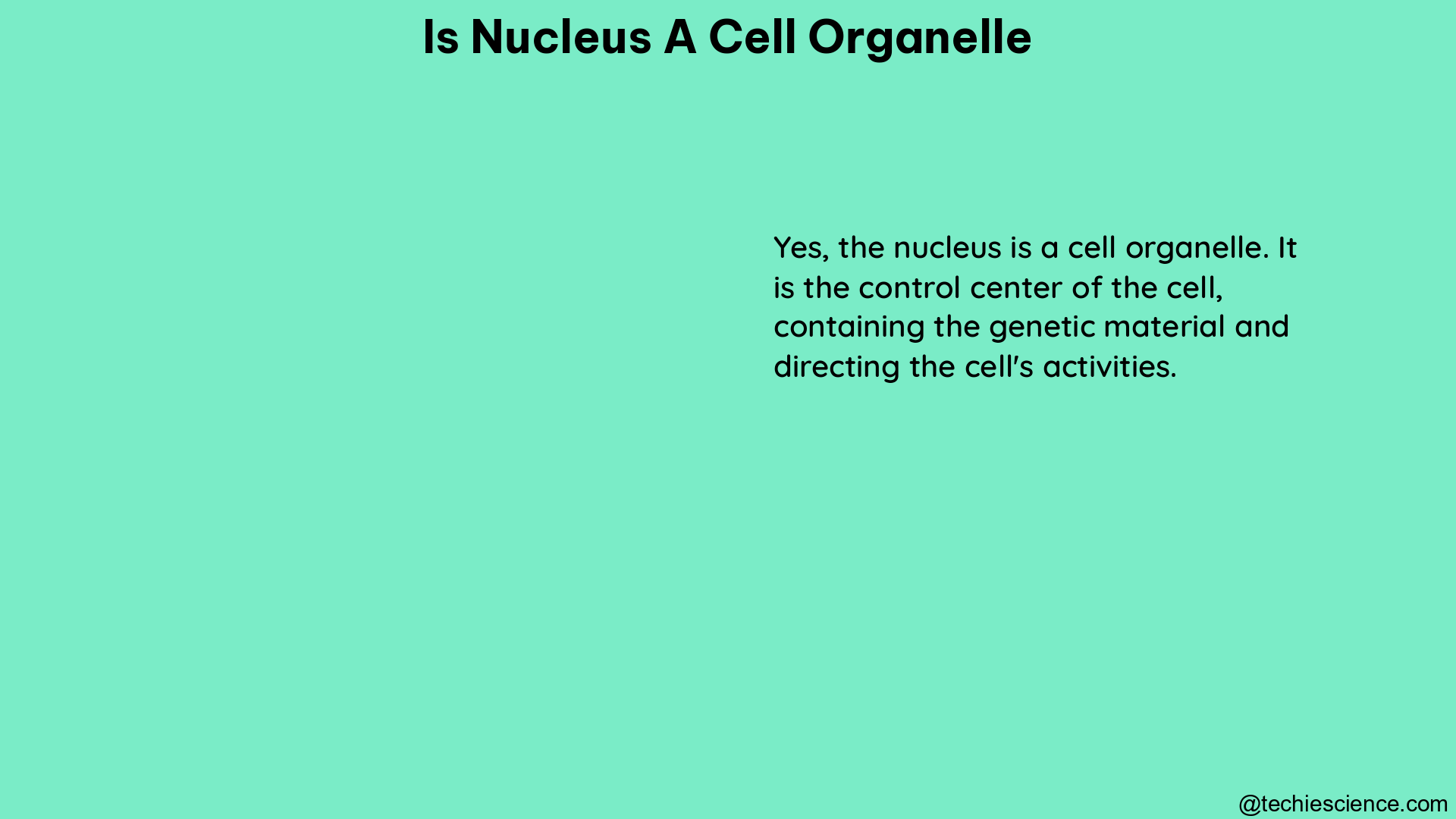The nucleus is the largest and most prominent organelle in eukaryotic cells, playing a crucial role in cellular function and organization. As the control center of the cell, the nucleus houses the genetic material and coordinates various cellular processes, making it an essential component of the cell’s structure and function.
The Nucleus: Structure and Composition
The nucleus is a highly complex and organized structure, consisting of several distinct components:
-
Nuclear Envelope: The nuclear envelope is a double-membrane structure that surrounds the nucleus, separating the nuclear contents from the cytoplasm. It is composed of an inner and outer membrane, with the space between them known as the perinuclear space.
-
Nuclear Pores: Embedded within the nuclear envelope are nuclear pores, which act as gateways, regulating the exchange of materials between the nucleus and the cytoplasm.
-
Nuclear Lamina: The nuclear lamina is a network of proteins that provide structural support and organization to the nucleus, anchoring the chromatin and other nuclear components.
-
Chromatin: Chromatin is the complex of DNA and associated proteins that make up the genetic material within the nucleus. It is organized into distinct structures called chromosomes, which contain the genetic information necessary for cellular function and inheritance.
-
Nucleolus: The nucleolus is a distinct, dense region within the nucleus that is responsible for the synthesis and assembly of ribosomes, the cellular organelles responsible for protein synthesis.
-
Other Nuclear Bodies: The nucleus also contains other specialized structures, such as Cajal bodies, PML bodies, and nuclear speckles, which play various roles in nuclear organization and gene expression regulation.
Quantitative Analysis of the Nucleus

Advances in microscopy and image analysis techniques have enabled researchers to quantify various structural and functional aspects of the nucleus. Some key quantitative data points include:
-
Nuclear Size and Shape: The size and shape of the nucleus can vary significantly across different cell types and physiological conditions. Measurements of nuclear diameter, volume, and aspect ratio provide insights into nuclear organization and function.
-
Chromatin Organization: The compaction and distribution of chromatin within the nucleus can be quantified using techniques like super-resolution microscopy and chromosome conformation capture (Hi-C) analysis. These data reveal the dynamic nature of chromatin organization and its impact on gene expression.
-
Nuclear Pore Density and Distribution: The number and distribution of nuclear pores within the nuclear envelope can be quantified using techniques like electron microscopy and fluorescence-based imaging. This information is crucial for understanding nuclear-cytoplasmic transport and signaling.
-
Nucleolar Size and Activity: The size and activity of the nucleolus, as measured by its volume and the intensity of nucleolar markers, can provide insights into cellular metabolism and ribosome biogenesis.
-
Nuclear-Cytoskeletal Interactions: The mechanical coupling between the nucleus and the surrounding cytoskeleton can be quantified using techniques like atomic force microscopy and traction force microscopy. These measurements reveal the role of the nucleus in cellular mechanics and mechanotransduction.
Techniques for Quantitative Analysis of the Nucleus
Several advanced microscopy and image analysis techniques have been developed to quantify the structural and functional characteristics of the nucleus:
-
Confocal Microscopy: Confocal microscopy allows for high-resolution, three-dimensional imaging of the nucleus and its components, enabling the quantification of nuclear size, shape, and the distribution of nuclear structures.
-
Super-Resolution Microscopy: Techniques like stimulated emission depletion (STED) microscopy and single-molecule localization microscopy (e.g., STORM, PALM) can achieve nanometer-scale resolution, providing unprecedented insights into the organization of chromatin and other nuclear structures.
-
Automated Segmentation and Quantification: Software tools like CellProfiler and OrganelleProfiler can automatically segment and quantify various nuclear features, such as size, shape, and the abundance and distribution of nuclear components.
-
Chromosome Conformation Capture (Hi-C): Hi-C is a powerful technique that maps the three-dimensional organization of chromatin within the nucleus, revealing the spatial relationships between different genomic regions.
-
Atomic Force Microscopy (AFM): AFM can be used to measure the mechanical properties of the nucleus, including its stiffness and deformability, providing insights into the role of the nucleus in cellular mechanics and mechanotransduction.
-
Traction Force Microscopy (TFM): TFM can quantify the forces exerted by the cytoskeleton on the nucleus, elucidating the mechanical coupling between the nucleus and the surrounding cellular environment.
Applications and Implications
The quantitative analysis of the nucleus has numerous applications in various fields of biology and medicine:
-
Cell Biology: Understanding the structure and function of the nucleus is crucial for elucidating fundamental cellular processes, such as gene expression, DNA replication, and cell division.
-
Developmental Biology: Changes in nuclear organization and chromatin structure during development and differentiation can provide insights into the regulation of cell fate and lineage specification.
-
Cancer Biology: Alterations in nuclear morphology and chromatin organization are hallmarks of cancer cells, and quantitative analysis of the nucleus can aid in cancer diagnosis and prognosis.
-
Stem Cell Biology: The unique nuclear characteristics of stem cells, such as their chromatin organization and nuclear-cytoskeletal interactions, are important for maintaining stemness and regulating differentiation.
-
Mechanobiology: The mechanical properties of the nucleus and its interactions with the cytoskeleton play a crucial role in cellular mechanotransduction, influencing processes like cell migration, differentiation, and tissue homeostasis.
-
Aging and Disease: Changes in nuclear structure and function have been associated with various age-related diseases and neurodegenerative disorders, highlighting the importance of the nucleus in cellular aging and pathology.
In conclusion, the nucleus is a highly complex and dynamic organelle that is essential for the proper functioning of eukaryotic cells. The quantitative analysis of the nucleus, enabled by advanced microscopy and image analysis techniques, has provided valuable insights into the structural and functional characteristics of this crucial cellular component, with far-reaching implications in various fields of biology and medicine.
References:
- Stephens, A. D., Banigan, E. J., & Marko, J. F. (2019). Chromatin’s physical properties shape the nucleus and its functions. Current Opinion in Cell Biology, 58, 76-84.
- Stephens, A. D., Banigan, E. J., Adam, S. A., Goldman, R. D., & Marko, J. F. (2017). Chromatin and lamin A determine two different mechanical response regimes of the cell nucleus. Molecular Biology of the Cell, 28(14), 1984-1996.
- Caragine, C. M., Haley, S. C., & Zidovska, A. (2018). Surface fluctuations and coalescence of nucleolar droplets in the human cell nucleus. Physical Review Letters, 121(14), 148101.
- Maeshima, K., Ide, S., Hibino, K., & Sasai, M. (2016). Liquid-like behavior of chromatin. Current Opinion in Genetics & Development, 37, 36-45.
- Xia, Y., Ivanovska, I. L., Zhu, K., Smith, L., Irianto, J., Pfeifer, C. R., … & Discher, D. E. (2018). Nuclear rupture at sites of high curvature compromises retention of DNA repair factors. The Journal of Cell Biology, 217(11), 3796-3808.

Hello, I am Piyali Das, pursuing my Post Graduation in Zoology from Calcutta University. I am very passionate on Academic Article writing. My aim is to explain complex things in simple way through my writings for the readers.